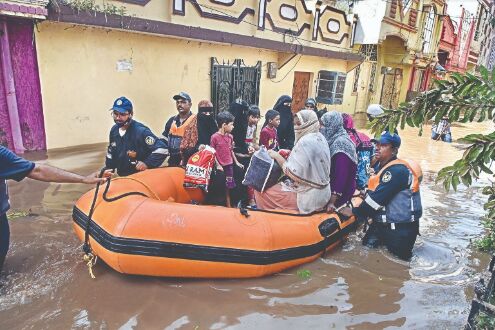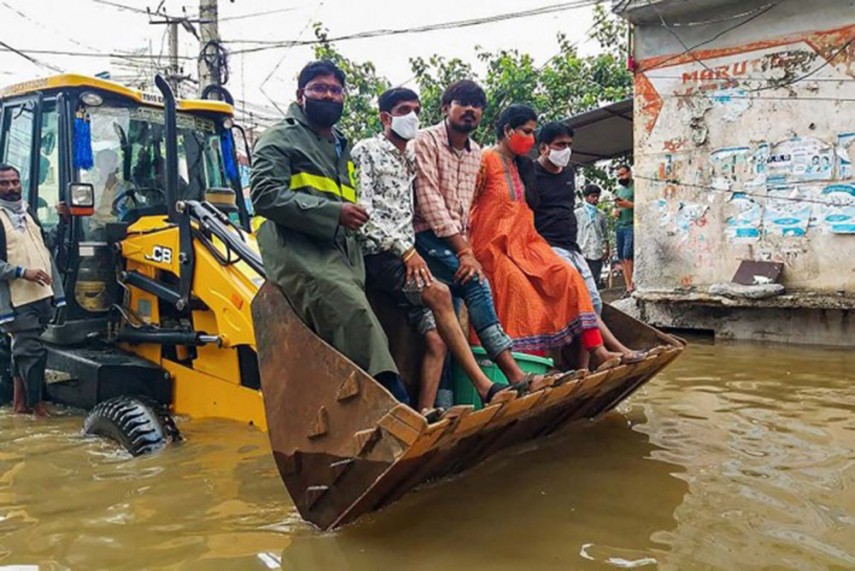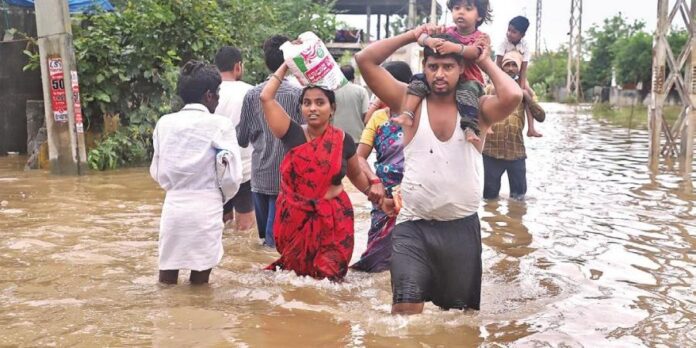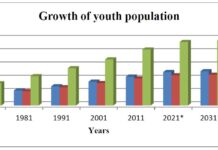Extremely huge rainfall on 12, 13 and 14 October 2020, and later in Hyderabad will be stuck in the pages of history. After the floods in 1908, Hyderabad faced limited area floods in 2000, in 2006, and in 2016. It is true that the floods in 2020 have exceeded all such events, in terms of spread, intensity and devastation. For the first time, the floods were seen in almost all areas across Hyderabad city. Water drain system in the Old city of Hyderabad was good. With increased population, this old system does not have enough capacity for the precipitation brought by current rains, where the water flow has become rapid and causing severe losses. Normally, natural disasters are unexpected, untold, unknown. But, in the last two months, there has been a considerable rainfall across Telangana, especially in Hyderabad.
Warnings were given. Yet there is no preparation from the Telangana government. We have modern communication systems and satellite-based forecasting forecasts, but have ignored flood forecasts. Government did not wake up from its slumber even after disastrous floods in Warangal, Karimnagar, Mulugu and other districts. There is no prior preparation or post event review. In Hyderabad, prior to October floods, rains have been frequent over the last few days and all the tanks have been filled. Water was released from Hussain Sagar in the heart of Hyderabad city twice in recent period. With such situation, more rains would have resulted in floods. Even though it is known that the rain will worsen, government machinery remained under-prepared. People were not taken into confidence, mobilized and made aware of.

Weather is no longer the same as before. We have many signs of such extreme weather. However, we have not prepared ourselves for such changes. The heavy rainfall in July 2005 in Mumbai city was not limited to that year. That was huge rainfall in 100 years. Yet, every year there was a heavy rain. In 2020 also Mumbai received the second highest rainfall. Chennai city also suffered heavy rain in 2015 and caused loss of life and property. Records say that this was more than the rain in 1901. Bangalore city also received 129 mm of rainfall after 127 years on August 15, 2017, in just 3 hours. We have seen heavy rains and subsequent floods in Delhi. There are heavy rains in Calcutta. When it comes to city planning and infrastructure, Calcutta is not better than Chennai. In fact, every Indian coastal city is stressed by heavy rainfalls.
Despite the heavy rainfall events in every modern and mega city, dangerous and horrific experiences therein, the Telangana government ignored the need for preparation in Hyderabad city. Mumbai, Calcutta and Chennai are coastal cities. On the other hand, Hyderabad city is located on the Deccan Plateau, 600 meters above the sea. Floods came in a geographical location where water was difficult to find. Hyderabad city managers did not learn from the experience of other cities. Drainage system was not planned properly. Presently, water drainage system in this city is in shambles.
Climate change is happening. There has never been such rainfall in just two days. This heavy rainfall was caused by a climate change. All the metropolises are eco-destructive centers. Air pollution generated in cities is one of the major causes of the increase in earth’s temperature. While climate change caused by environmental destruction is the cause of the intensive rainfall, let us not forget that the problem faced by the city of Hyderabad is due to human errors. Every time it rains, we see incidents of submergence of roads and houses in one area or the other of Hyderabad. However, it is sad that GHMC is not clearly prepared to deal with the floods in the city. Had the GHMC been prepared and took necessary action when the problem was small, it would not have been a disaster. Millions of people would not become victims of this horrific disaster. Loss of life and property could have been avoided.
Floods caused by sudden stress on the local drainage system (drainage network) are different from the river floods. In many places, nala encroachment has reduced the flow of water to less than two meters wide. Causes of this disaster are obvious to all. The water storage capacity in the lakes and tanks in Hyderabad city (impounding capacity) has decreased drastically due to encroachment of water sources, ponds, lakes and kuntas and other water sources, causing floods. Large tanks like Hussain Sagar, Osman Sagar, Himayat Sagar are shrinking with active occupation by government and private people. Their area is decreasing. Secondly, the flow and speed of water has also increased due to concrete structures and roads throughout the city. Low lands were flooding with minimal rains. There is no open land, not enough space between buildings, which leads to water inundating roads. With encroachment of drains and choking by garbage, water flow is taking to the streets. In the recent past, even though GHMC and the government have announced that encroachments would be removed on war footing, field situation has not changed.
In fact, it is the government that has encroached water bodies. Government agencies throughout the city have occupied water resources. The Mahatma Gandhi Bus Station (MGBS), the Municipal Waste Transit station by the GHMC in the Musi River, the sewerage treatment plant set up by HMWSSB, the station built by Hyderabad Metro Rail Company in the bed of River Musi, Maithrivanam Building in Ameerpet, the Necklace Road around Hussain Sagar, Lumbini Park and other monuments are some examples. Once Hyderabad was known for lakes and parks. In the last 20-30 years, many tanks, ponds and canals that linked lakes and kuntas have been encroached and transformed themselves into huge houses and buildings. Whenever there is rain, water reaches these low lands. For people living there, this natural accumulation is a flood phenomenon.

The Musi River has also been severely encroached in many places. From Sangam to Nagole, the width of the river has decreased by 70 per cent in many places. After the High Court building, river width has been reduced by the government and government agencies to just 6 meters. Encroachment by private people has reduced the river width by more than 50 per cent near Chadarghat Bridge. From there, the encroachment continues to Moosarambagh Bridge. Because of encroachments, normal flow of water becomes a flood. With increase in flows caused by heavy rainfall, flood intensity and extent of flooding increases. Heavy rainfall on 14th October, 2020, caused this situation.
The Hyderabad Metropolitan Development Plan is under-developed. There is no comprehensive, sustainable, long-term plan. Even as Hyderabad became “Greater”, Telangana government’s interference in local self-government increased. There is no regulation of building construction, as permissions and approvals became simplified. Lack of adherence to engineering principles in newly constructed flyovers and viaduct of Hyderabad Metro Rail have also created floods and new types of ponds in many places and have adversely affected the city’s life and travel.
Overall, the Telangana government was unprepared for these floods, even though there was have been warning signs. It did not even mobilise the people. GHMC lost the ability to take its own decisions. Lack of coordination between the various government departments and government agencies was evident. Even after the disaster, with floods spread throughout the city, response from the government is not on par. Even though there are 5 lakh cameras across Hyderabad city, the delay in information collection is palpable. There are doubts if there will be a proper post-disaster assistance programme for the families who have been impacted adversely and displaced severely.
Telangana government needs to improve the Hyderabad water drainage system to prevent future disgana.asters. There is a need to protect the tanks. The encroachment on water resources has to be removed, through implementation of a planned and the rehabilitation scheme for poor and middle-class families. Heavy rainfall can occur in Hyderabad, again and again, given the unpredictable global weather patterns. No one guarantee that there will be no such rainfall again. In view of that, it is necessary for the government, municipalities and citizens to be prepared in Telangana




